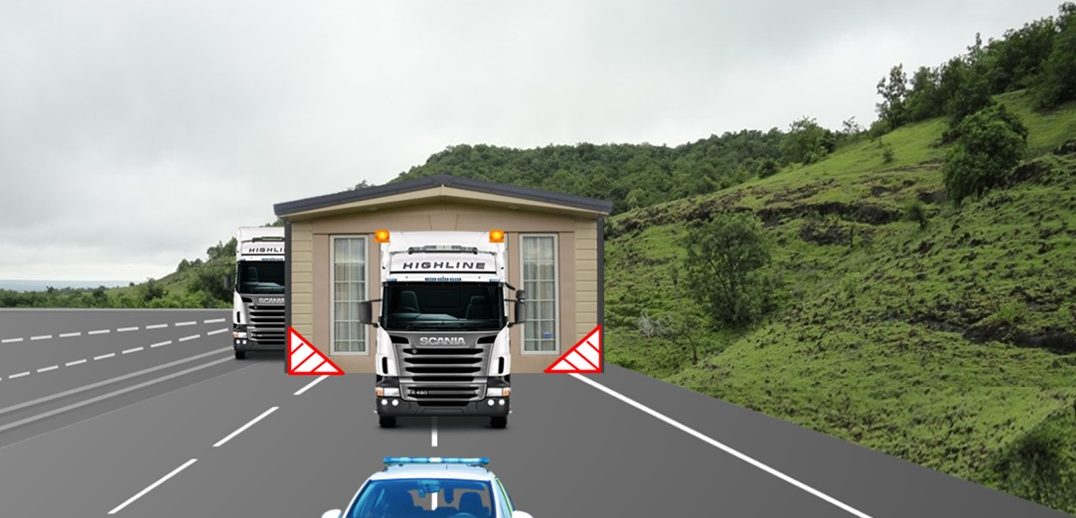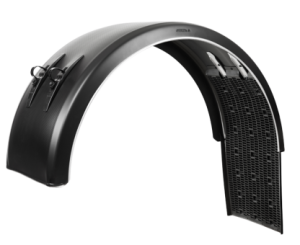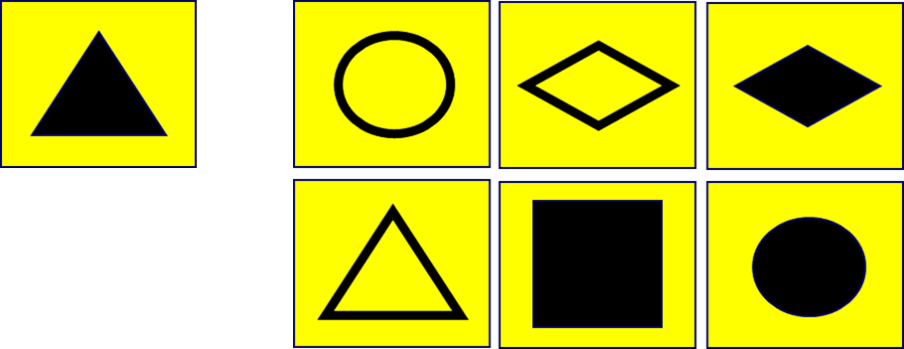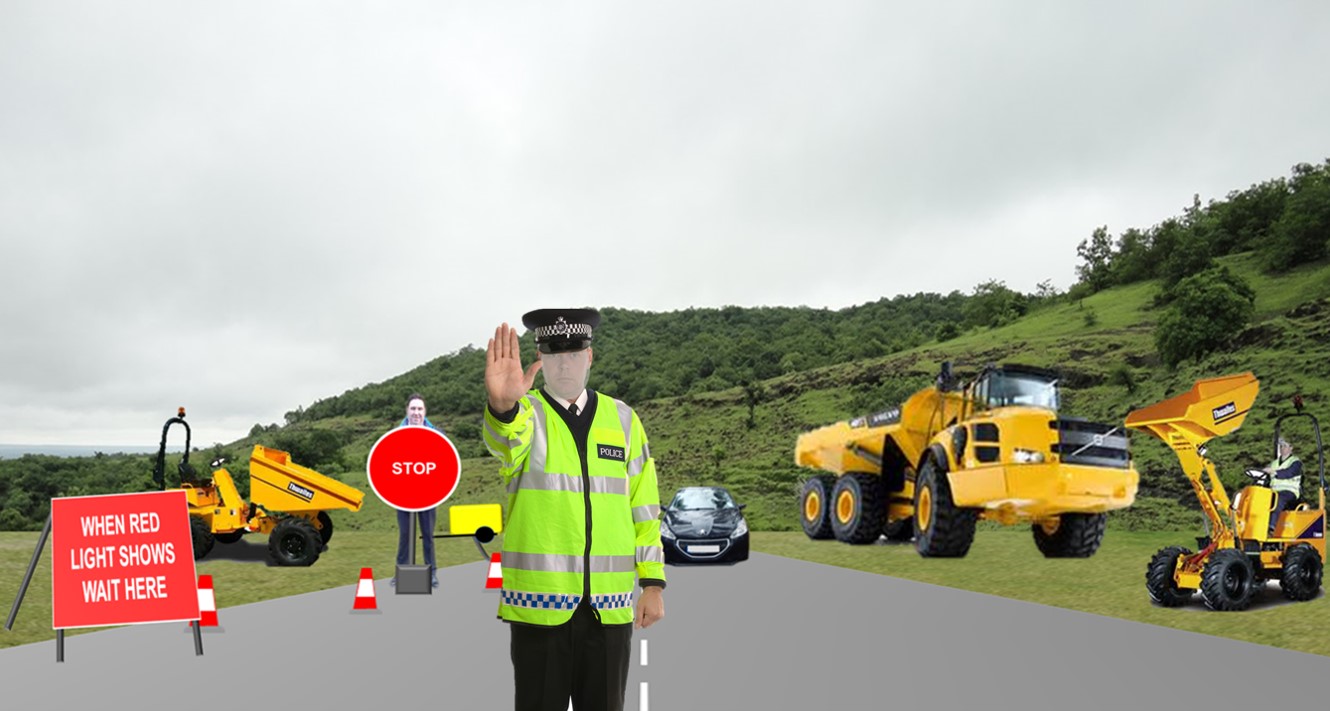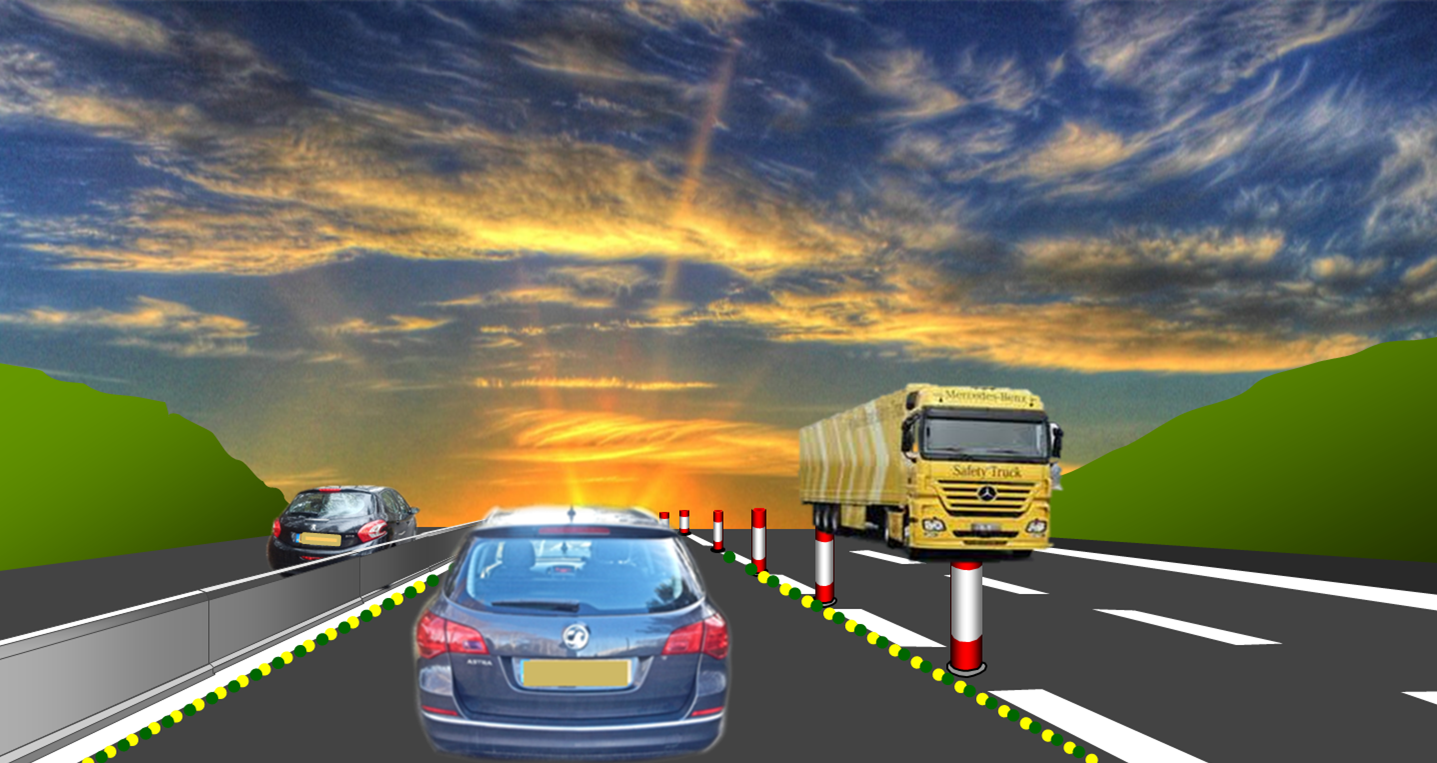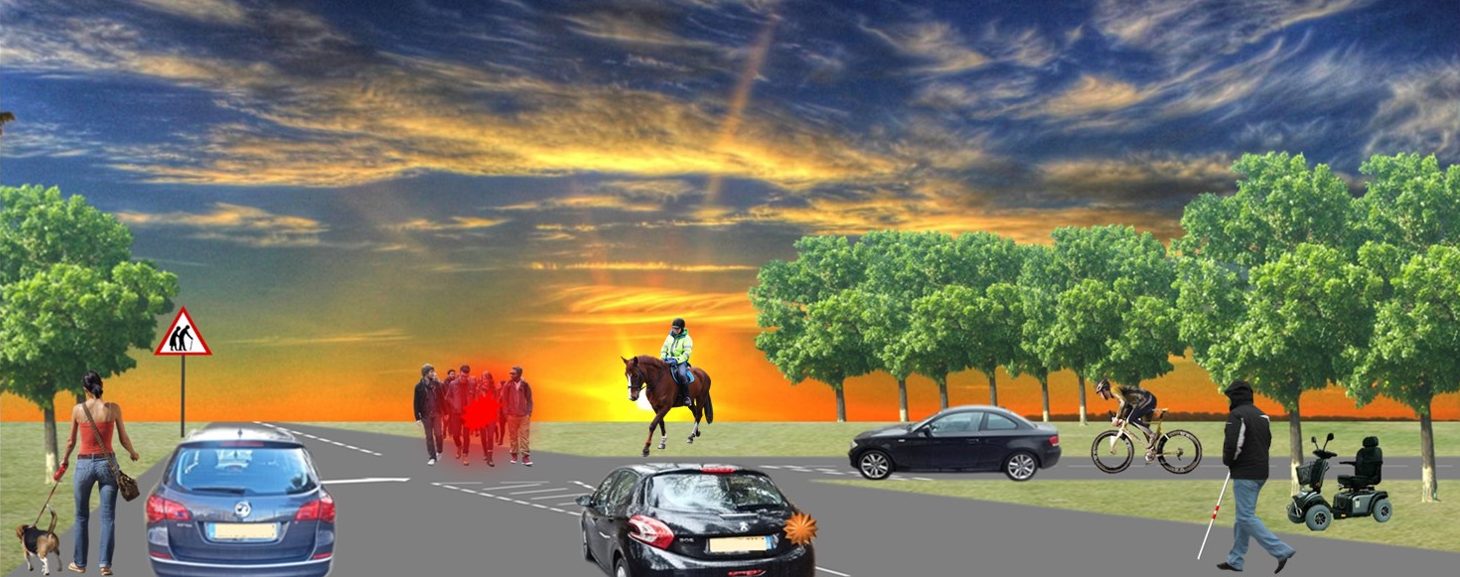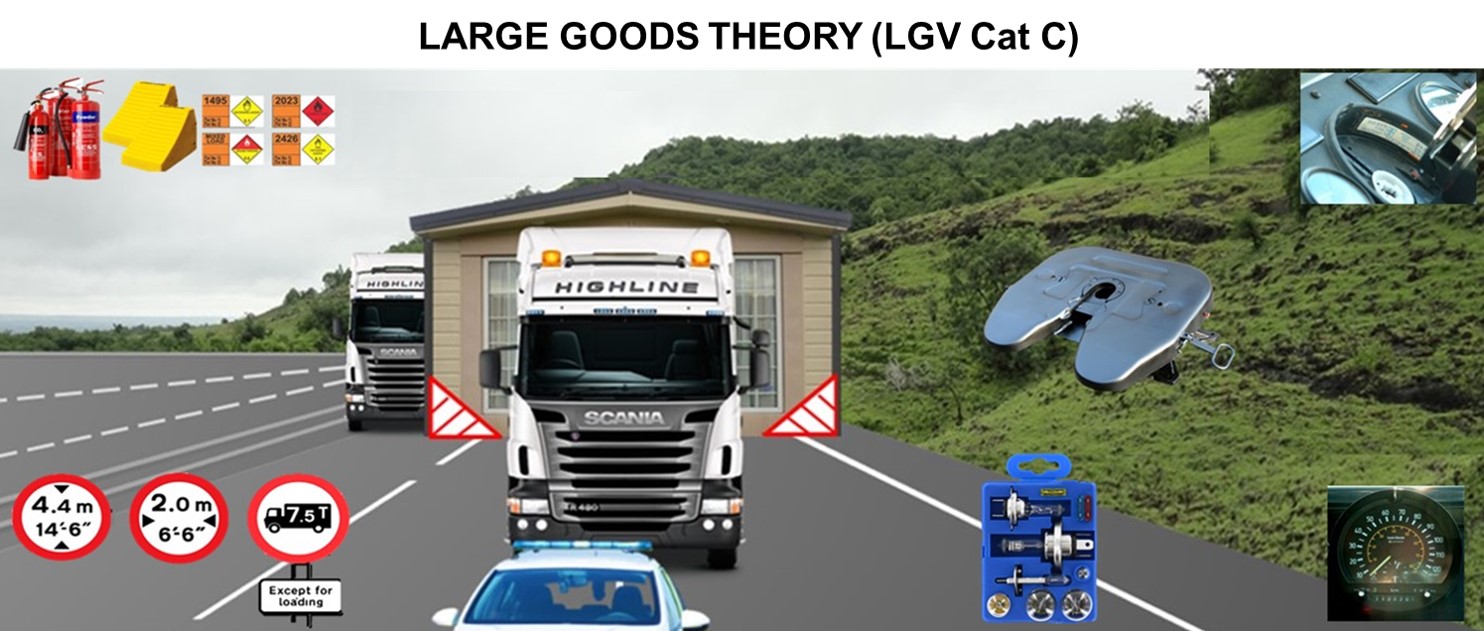RULES OF THE ROAD
Driving a large goods vehicle will require the driver to show extra consideration for all other road users. You may need to wait and be patient in situations that, as a car driver, you would not need to consider.
The length, height and weight of your vehicle will not only impact other road users, it will also effect environmental issues. You must always plan your journey in advance.
If you do not plan your route carefully the impact of your vehicle can add to the local council road repair bills. Additionally, the vibration your vehicle emits can damage underground services such as electric, gas and water. It can also damage older building foundations. ALWAYS plan your route.
SEPERATION DISTANCES
On normal, dry roads the separation distance between you and the vehicle in front should be gauged by you as 1 metre per mile per hour. If you are driving at 50mph the separation distance should be 50 metres, this will allow you to stop under control.
In wet conditions it can take you twice the distance to stop and in Icey conditions up to ten times the distance.
OVERTAKING
You must never overtake a cyclist or vehicle if you are planning to turn left, stay back and be patient.
When you make the turn be prepared to slow down or stop for pedestrians.
It is important to remember the length of your vehicle when overtaking. Unlike a small car, you must consider the total length of your vehicle and whether you have the space and time to complete this manoeuvre without causing danger to other vehicles. You should not overtake unless you can see clearly ahead.
Before overtaking you must consider the speed limit for the road and whether you would break the limit carrying out this manoeuvre.
You must consider whether you will cause other vehicles to slow down or change direction to avoid you. If a lorry is overtaking you and you realise that it has not got the speed to safely pass you, slow down and let the other vehicle overtake you safely.
You must take into consideration uphill gradients and the effects on your vehicle. When planning to overtake you must make sure that their are no junctions ahead of you. Vehicles ahead of you could be planning to turn right.
Remember the effects of your speed limiter on your vehicle.
On dual carriageways and motorways an extra lane called the crawler lane has been provided. Use this lane where possible as this will help traffic flow. When the crawler lane ends you must return carefully to the main carriageway.
When overtaking on a motorway, due to the size of your vehicle and the additional blind-spots, you must be certain that any lane changes required are done safely. On a three-lane motorway other traffic could be planning to use the same lane you intend to.
Remember other drivers need time to react, because of the restrictions on your vehicle. You must also take into consideration the fact that other vehicles could be driving at much faster speeds. Be prepared to adjust your speed. Once you have completed the overtake and it is safe to do so, get back into the left-hand lane. In all circumstances you must avoid cutting other vehicles up.
If your vehicle is over 7.5 tonnes maximum authorised mass (MAM), you cannot use the right-hand lane of a three-lane motorway. There are only two exceptions, if instructed to do so by the escort of a wide load or the left-hand lane is closed. If it is a two-lane motorway then you can use both lanes
At night time overtaking can cause additional problems. It makes distances difficult to judge and on normal roads, you have the added problems of hidden dips and bends. Always make sure it is safe before carrying out any manoeuvre.
On normal roads, when overtaking stationary traffic be prepared for car doors opening. At night cars can park in many rural areas without displaying parking lights. Take care when passing them.
ROAD POSITION
Always adopt the correct road position whatever road system you are driving on. You may, however depending of the size of your vehicle, need to take up a different road position at junctions and roundabouts.
In all situations you must avoid mounting a kerb and maybe need to straddle lanes to achieve a safe turn. Be aware of other vehicles including cyclist moving down your nearside.
At roundabouts when turning right you may need to approach in the left-hand lane. Approach with care with your right signal on.
MINI ROUNDABOUTS
Junctions that have caused issues with the flow of traffic are sometimes changed and replaced with mini roundabout. They are painted on the road surface, and unlike proper roundabouts they
have no kerb.
You must try to go around the white circle of the roundabout and not just drive over them. The longer your vehicle, the harder it is to not drive over part of the painted surface.
WINTER
Road surfaces are made up of different compounds. Some surfaces are concrete, which will create extra road noise, the majority, however, are tarmac surfaces. In wintry weather they all have something in common – surface water can freeze and create a problem for vehicles of this size. During daylight hours you are aware of the changing road conditions, but when it becomes dark the changes are less recognised. If your steering becomes lighter there could be a possibility that there is ice or frost on the road surface. Reduce your speed slowly until full control is gained. Do not brake as you could lose control.
SNOW
If you must drive in snowy conditions, you will find that your large goods vehicle (LGV) will react differently to a car. All LGVs are rear wheel drive and you can, if not driven correctly, lose control in inclement weather.
 In snow always drive in the highest gear available with the minimum of revs. Always brake gently and avoid any sudden changes of direction. If you get stuck in snow engage the Diff lock as covered in the vehicle section.
In snow always drive in the highest gear available with the minimum of revs. Always brake gently and avoid any sudden changes of direction. If you get stuck in snow engage the Diff lock as covered in the vehicle section.
 Always carry in additional cloth sacks and a shovel. Cloth sacks can be placed under the wheels to give you extra grip.
Always carry in additional cloth sacks and a shovel. Cloth sacks can be placed under the wheels to give you extra grip.
In addition you can fit snow chains, they will give you extra grip in deep snow,
You can not stop on the hard shoulder to fit snow chains under any circumstances.
If you do find yourself driving in deep snow and see a snow plough ahead, stay behind as they will clear the road.
 Remember it could take you up to ten times the distance to slow and stop your vehicle.
Remember it could take you up to ten times the distance to slow and stop your vehicle.
RAIN
When driving in heavy rain visibility can be greatly reduced. You must slow down to a safe speed, a speed that gives you full control and observation. Make sure that your dipped headlights are on and if visibility is less than 100 yards switch on your fog lights.
 Anti-spray suppression equipment (mud flaps with brushes) are fitted to most modern day LGV’s, this equipment only helps other road users as they are following you.
Anti-spray suppression equipment (mud flaps with brushes) are fitted to most modern day LGV’s, this equipment only helps other road users as they are following you.
Heavy rain will increase your stopping distance to double the normal distances, you must increase the distance from the vehicle in front. Remember the heavy spray from your vehicle can and will impact on another vehicles visibility.
It is not just your vehicle that you must consider, other road users may also need your undivided attention. In wet conditions motorcyclists (Mopeds) may need to take an alternate direction to avoid simple things like potholes and drains.
DEEP WATER
In some rural areas you may need to cross deep water. These crossings are called fords and they have depth of water gauges. If you must drive through these, always use a low gear with a reasonably high engine speed.
 If your exhaust is mounted low on the vehicle it will prevent the water entering your exhaust system. Once you have cleared the ford you must check your brakes, you may need to drive slowly with the foot brake lightly applied. The heat from the friction will help to dry your brakes out.
If your exhaust is mounted low on the vehicle it will prevent the water entering your exhaust system. Once you have cleared the ford you must check your brakes, you may need to drive slowly with the foot brake lightly applied. The heat from the friction will help to dry your brakes out.
FOG
When driving in fog remember if visibility is less than 100 metres switch on your fog lights. Once the visibility increases, switch the fog lights off as it will make your brake lights more difficult to see by others.
If you are driving on the motorway in thick fog remember the red marker studs should be to your left and white to your right. This is telling you that you are in the left-hand lane. Increase the distance from the vehicle in front do not tail gate.
WINDY CONDITIONS
Because of the size and height of some vehicles, high winds can have a massive impact on your vehicles driving characteristics. The surface area of your trailer can act as a huge parachute, trapping the wind, and in some extreme circumstances, blowing your vehicle off course.
 When driving in windy conditions there will be times that your vehicle will be sheltered from cross winds. Trees and hills make good protective barriers. When driving under bridges this also will protect your vehicle from the elements.
When driving in windy conditions there will be times that your vehicle will be sheltered from cross winds. Trees and hills make good protective barriers. When driving under bridges this also will protect your vehicle from the elements.
Bridges are built on raised surfaces to give the height for vehicles to pass under them. You must be aware of the impact of cross winds when your vehicle clears these structures.
The impact of windy conditions will also be experienced on viaducts and open roads. A viaduct is a high-level bridge that has been built to cross valleys. It is an open road without natural wind barriers.  To help reduce the impact of the wind you must plan a route that keeps you to less exposed roads which avoid high bridges and viaducts.
To help reduce the impact of the wind you must plan a route that keeps you to less exposed roads which avoid high bridges and viaducts.
If you are driving a curtain sided vehicle and it is empty, tie the curtains back allowing the wind to pass through. Failure to carry this simple thing out could result in loosing control of your vehicle.
 You may find that when windy conditions have been forecast a lane has been conned off on dual carriageways and motorways on open sections and high bridges.
You may find that when windy conditions have been forecast a lane has been conned off on dual carriageways and motorways on open sections and high bridges.
 This is called a buffer lane.
This is called a buffer lane.
The lane has been closed purely for safety reasons as, if for whatever reason, your vehicle is hit by a high side wind, it allows your vehicle to be blown of course.
When passing vulnerable road users, a vehicle can act as a shield and once you have passed, the wind can cause them problems. This is called buffeting.
In addition to high sided vehicles, light box vans, caravans, motorcyclists and cyclists are all at risk. They could also be blown into your path. Always allow extra room, making sure that other motorists are in control.
For all motorists the biggest impact is fallen trees, listen to the local radio station and be prepared.
TUNNELS
When driving through tunnels there are certain procedures you must do as a driver.
•Before entering a tunnel make sure that you remove your sunglasses.
•Tune your radio into the local radio station, this will keep you informed of any additional problems you might incur.
 •Switch on your dipped headlight.
•Switch on your dipped headlight.
•If in a traffic queue, leave at least 5 metres between you and the vehicle in front, apply your handbrake and release your foot-brake. This is so you do not dazzle drivers behind you.
•If the tunnel has blue separation markers (Cats eyes), keep the required amount of separation markers between you and the vehicle in front.
 If your vehicle breaks down in a tunnel, you must stay with it in your cab. Turn on your hazard warning lights. If your vehicle catches fire in a tunnel, If possible try to drive it until you reach a safe place. If your vehicle is unable to be driven safely, and you cannot extinguish the fire, you must if possible cut of the fuel supply to the engine.
If your vehicle breaks down in a tunnel, you must stay with it in your cab. Turn on your hazard warning lights. If your vehicle catches fire in a tunnel, If possible try to drive it until you reach a safe place. If your vehicle is unable to be driven safely, and you cannot extinguish the fire, you must if possible cut of the fuel supply to the engine.
If you can not prevent further danger then you must leave the
tunnel via the signed emergency exits.
ARCHED BRIDGES
When planning your route you may need to use roads with low arched bridges. Provided the height of your vehicle does not exceed the maximum height of the bridge, you must:
 •Keep within the height markers, both on the road and above the bridge.
•Keep within the height markers, both on the road and above the bridge.
•Where possible move to the centre of the road early, but be prepared to give way to oncoming traffic.
•Look for diversions that avoid low bridges.
GATED LEVEL CROSSINGS
When delivering goods, you may have to drive over a gated level crossing.
These crossing are operated by you the driver.
•Ring the signal man on the phone provided to make sure that it is safe for you to open the gates.
•Once crossed close the furthest gate from you first.
•Notify the signal man that you have crossed safely and have closed the gates.
RED ROUTES
Red routes are routes that should be kept clear at all times, unless you have broken down you must not stop on them. This poses problems for you as a driver when making deliveries.
There are special white boxes marked on the road surface for you to stop in. You must make sure that you only use these boxes within the times shown. Planning your deliveries is very important.
PARKING
You must try never to park and leave a large vehicle at the side of the road overnight. If you do leave a trailer over 1,525 kg on a two way road at night it must be parked with the flow of traffic, and chocks placed under its wheels. You must also provide additional lights.
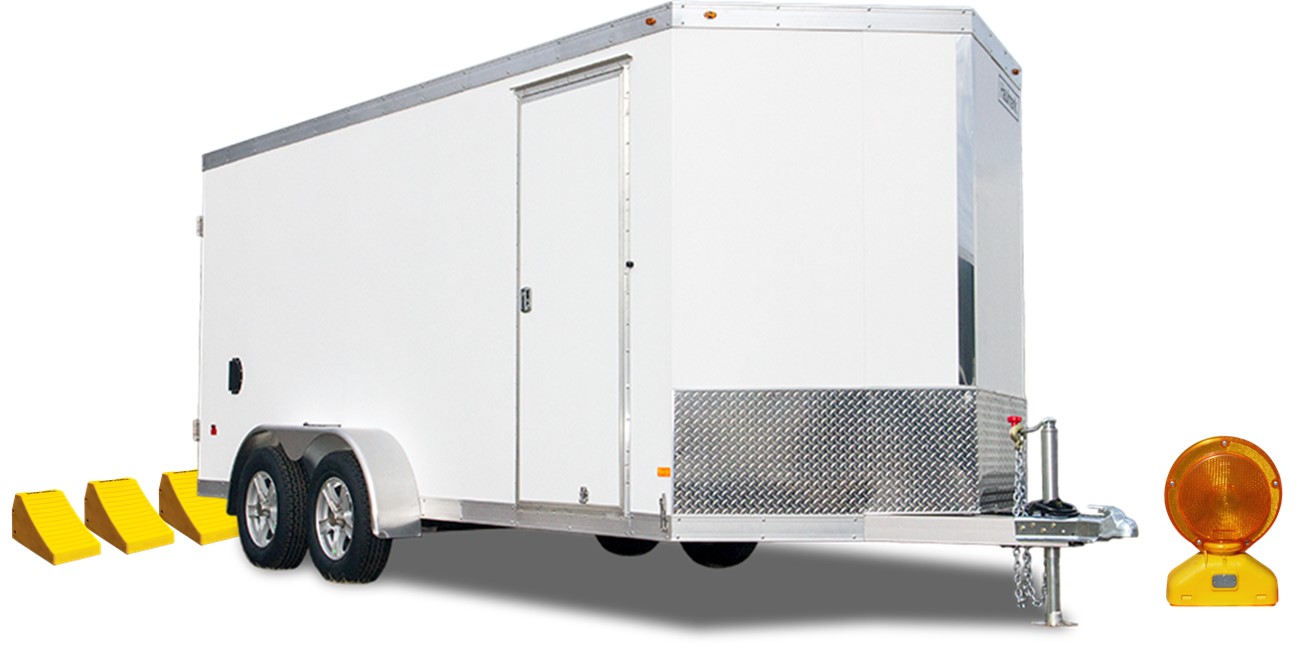 If leaving a skip on the roadside, it must have the correct weight markings if they apply, and additional amber flashing lights must be displayed.
If leaving a skip on the roadside, it must have the correct weight markings if they apply, and additional amber flashing lights must be displayed.
DIVERSIONS
At times it becomes necessary to close sections of motorway or other main roads. It could be simply down to extreme windy conditions. For safety reasons the road could be closed to high sided vehicles. If this happens an emergency diversion sign will be displayed. The sign has a yellow background displaying a black triangle. Follow the diversion sign and it will take you round the problem area and return you to your route.
In addition to help drivers navigate routes, permanent diversion signs may be displayed on existing signs. Different symbols on yellow backgrounds will be displayed allowing you the driver to take an alternate route.
ROAD WORKS
At roadworks you will find various restrictions. On a single carriageway one lane could be closed.
To give equal priority to all road users, the works will be controlled by various methods.
•Temporary traffic lights.
•Stop and go boards activated by a work man.
You must stop behind the red board until you have been authorised to move. When driving through the road works drive slowly as the lanes are narrow, and be extra vigilant as there could be workmen in the road.
When approaching roadworks on a motorway adjust your speed to the temporary maximum speed displayed. Show courtesy to other road users by merging in turn.
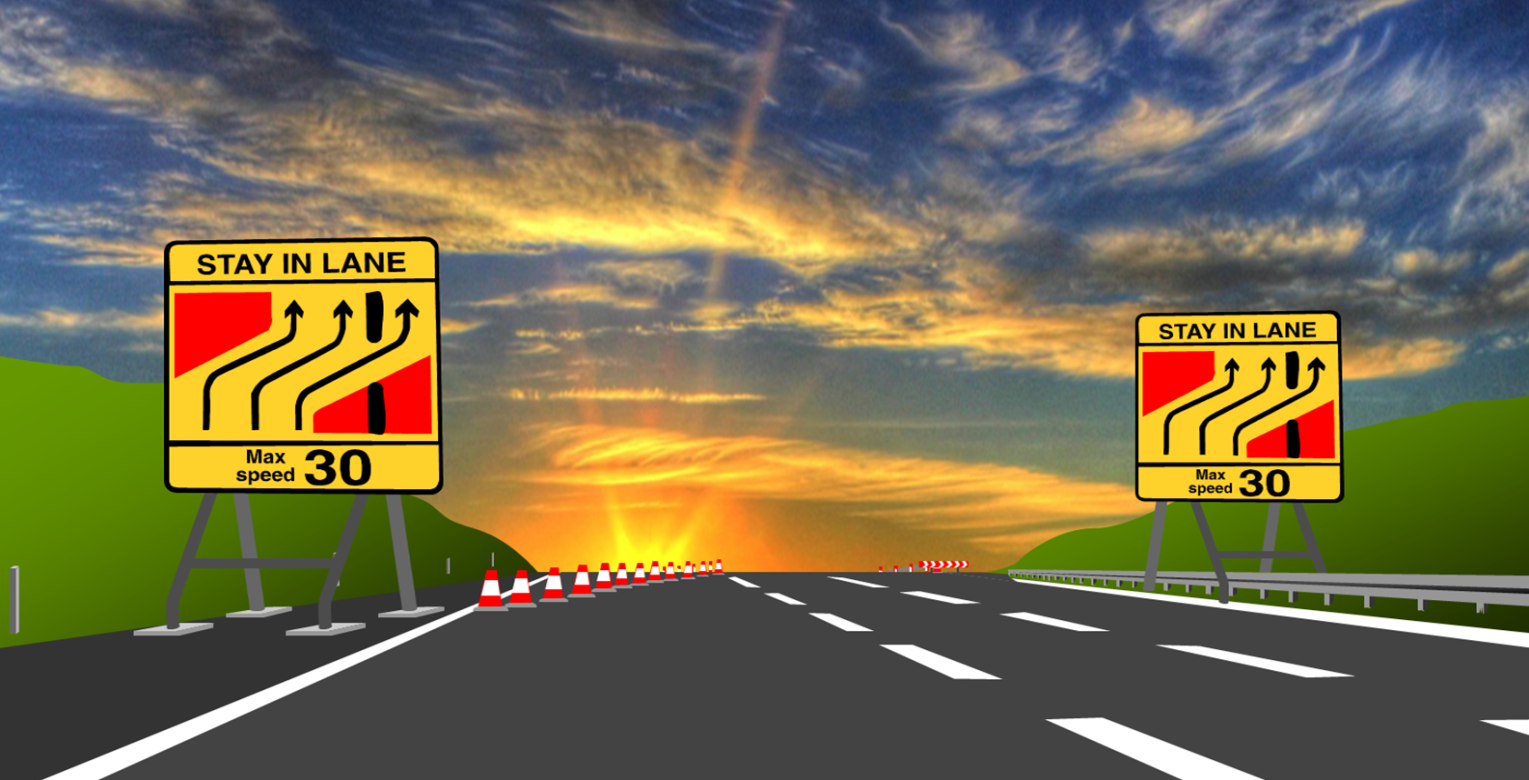 The lanes will be narrower, and you might find additional restrictions that apply to your vehicle because of its size.
The lanes will be narrower, and you might find additional restrictions that apply to your vehicle because of its size.
The motorway roadwork sign notifies you that the right hand lane crosses the centre reservation and utilities a lane in the opposite direction. This is known as a contraflow system. If driving a large goods vehicle over 7.5 tonnes maximum authorised mass you would not use the right lane in this situation.
When driving in a contraflow as the picture shows to the right there is no permanent barrier between you and the car travelling towards you. The lanes are separated by red and white posts. In addition to the posts the lane markers (Cats eyes are a different colour to normal. In roadworks on both dual carriageway and motorway the cats eyes are a yellow/green colour.
In addition to the temporary mandatory speed limits, you must be aware of workmen in the roadworks.
When approaching roadworks that are being set up or changed, be aware of workers in the roads carrying signs.
If you break down in roadworks, there is generally a free recovery service. You must stay with your vehicle until help arrives. Your vehicle will be recovered to the nearest safe point. You will need to provide your own recovery service from that point.
If you brake down on a motorway and have managed to stop on the hard shoulder, for additional safety reasons turn your front wheels into the verge.
VULNERABLE ROAD USERS
A group of pedestrians carrying a red light means it is an organised march or walk.
Sudden noise from your air brakes can cause the horse rider to loose control.
Pedestrians walking with flow might not hear or see you.
Cyclists and mopeds might suddenly change direction.
Mobility scooters are very slow, be patient.
Pedestrian using a white stick with red bands, means they are both deaf and blind.
Be prepared to slow down and stop for the elderly, their reactions are not as quick as they use to be.








